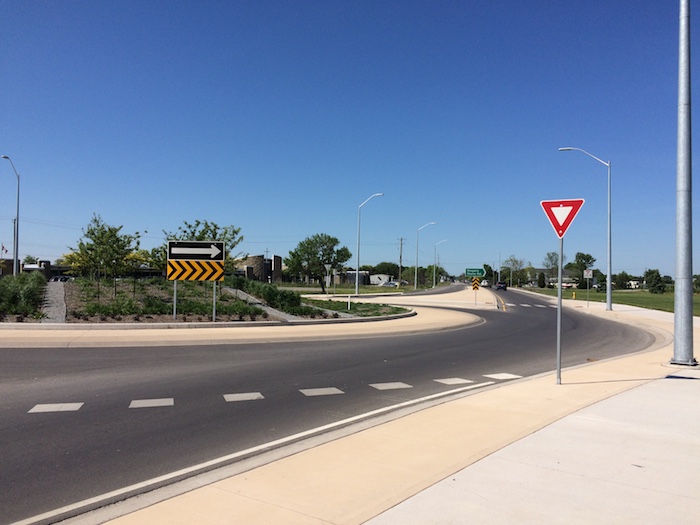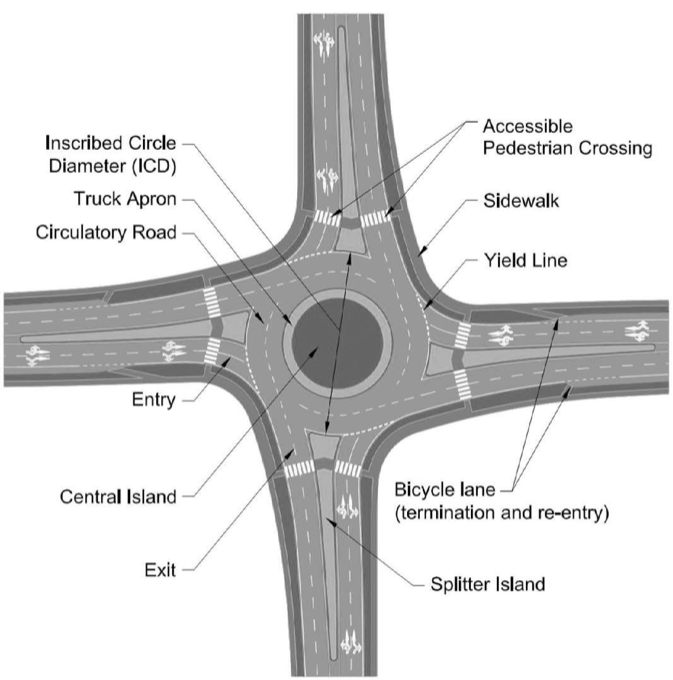
Round and About
June 28, 2018
By Gene Chartier, P.Eng., Michael MacDonald, P.Eng., Mitchell Jacobson, P.Eng., Michael Skene, Eng.L. and Tom Eichenbaum, P.Eng.
An overview of the Canadian Roundabout Design Guide, defining the intent and suitable applications for the traffic calming solution.
(this article first appeared in the June/July 2018 issue of Canadian Consulting Engineer magazine)

Niagara Stone Road roundabout, Niagara-on-the-Lake, Ont. (photo courtesy HATCH)
Roundabouts are becoming a more prominent intersection treatment across Canada. From the east coast to the west, decision makers have been convinced that roundabouts are safer, operationally superior and less expensive than comparable intersection treatments.
Until recently, there was no single source of guidance for the application and design of roundabouts in Canada. Recognizing the need for improved national guidance, the Transportation Association of Canada (TAC) developed the Canadian Roundabout Design Guide.
Published in 2017, the Guide provides recommended practices for the planning, design, construction, operation, maintenance and safety of roundabouts in Canada. The content of the Guide was based on research of other national and international best practice documents, along with extensive consideration of Canadian jurisdictions with roundabouts already in service. Two documents served as the principle sources of information for the Guide: American Roundabouts: An Informational Guide, Second Edition (NCHRP Report 672, Transportation Research Board of the National Academies, 2010); and the British Geometric Design of Roundabouts (Design Manual for Roads and Bridges, August 2007, Volume 6 – Road Geometry, Section 2 – Junctions, Part 3, TD 16/07).
What is a Roundabout?
A modern roundabout is a type of circular intersection in which vehicles travel counter-clockwise around a central island. Drivers entering the roundabout must yield to circulating traffic. Figure 1 (below) shows the basic geometric design and traffic control features of a roundabout.
Although the terms roundabout, rotary, and traffic circle are sometimes (inappropriately) used interchangeably, these different forms of intersection control have distinct features and characteristics. Roundabouts provide several advantages over traditional traffic circles and rotaries, resulting in superior safety and operational performance.
Different Types of Roundabouts
The Guide separates roundabouts into three categories:
- • Mini-roundabouts are small and characterized by a fully traversable central island and splitter islands that allow larger vehicles to manoeuvre through the intersection without travelling around the island. Mini-roundabouts, which differ from neighbourhood traffic circles, are commonly used in low-speed urban environments and locations where roadway right-of-way is not sufficient to accommodate a typical single-lane roundabout.
- • Single-lane roundabouts are characterized by single-lane entries and one circulatory lane. When compared to a mini-roundabout, the central island diameter is much larger, and the island is non-traversable. The geometric design often includes a non-traversable central island with a mountable truck apron, raised splitter islands, and crosswalks.
- • Multilane roundabouts are characterized by at least one entry with two or more lanes and in some cases may have a different number of lanes on one or more approaches. The circulatory roadway is wider to accommodate vehicles operating side-by-side and may have higher entry, circulating and exit speeds. The geometric design typically includes a non-traversable central island with mountable truck apron if required, raised splitter islands, and crosswalks. The circulatory roadway and exits are striped to accommodate each turning movement of the entry lane configuration in such a way as to require no lane changes for any movement through the roundabout.
Advantages and Disadvantages
Roundabouts offer several advantages over other forms of intersection traffic control, including:
- • Safety – Roundabouts have been proven to reduce the frequency and severity of collisions when compared to stop controlled and signalized intersections due to fewer conflict points, lower entering and circulating speeds and deflection on entry. Improving safety is the main reason road authorities construct roundabouts in North America.
- • Operational – Roundabouts often operate with lower delays and shorter queues than other forms of intersection control.
- • Traffic Management – Roundabouts can be a useful traffic management and calming tool, especially when used in conjunction with other measures in an overall plan.
- • Access – Roundabouts facilitate safer and more efficient turning movements at intersections and driveways and provide U-turn opportunities, eliminating the need for more difficult midblock left-turns.
- • Environment and Sustainability – Roundabouts decrease fuel consumption and vehicle emissions by reducing delays and idling time, consume less energy than traffic signals and require little maintenance.
- • Aesthetics – Roundabouts can provide an opportunity to create an aesthetically pleasing focal point within or adjacent to a community.
- • Economic – Roundabouts require less maintenance than traffic control signals, offer time and fuel savings to users, provide societal cost savings through less severe and fewer collisions, and alleviate the need for auxiliary turn lanes.
- Although there are many benefits of a roundabout, there are certain limitations to consider, including:
- • Spatial Requirements – Roundabouts may require more property because of their shape compared to a conventional stop-controlled or signalized intersection.
- • Construction Costs – Roundabouts may have higher initial construction costs due to a larger intersection footprint, complexity in traffic management, greater property acquisition and degree of landscaping.
- • Constructability – Retrofitting to install a roundabout may require a longer construction period and present greater complexity for traffic management and construction staging.
- • Operational – Approach volumes and traffic patterns may adversely influence roundabout capacity. Large vehicles can also impact operation.
- • Accessibility – Roundabouts may be more challenging to navigate for pedestrians with vision impairment or mobility challenges, and for cyclists.
- • Public Education – In communities where roundabouts are not common, new installations may require public education and outreach prior to implementation.

Figure 1. Basic geometric design and traffic control features of a Roundabout. (Source: Transportation Association of Canada*)
Where to Consider a Roundabout?
The decision to implement a roundabout depends on many factors such as the environment in which the roundabout is being considered, the capacity and operational characteristics of the subject intersection and adjacent road network, prevailing roadway geometry, safety, and a range of other site-specific influences. Their safety and operational attributes make them particularly suitable at intersections:
- With frequent collisions or a history of safety concerns
- With heavy left-turn volumes;
- Where higher-order traffic controls (i.e. all-way stop, traffic signals) are not warranted;
- With unusual or complex geometry;
- At interchange ramp terminals;
- Where a transition from a rural to an urban environment occurs.
Roundabouts may operate less optimally or be less effective than conventional intersection forms in certain locations. While this does not necessarily preclude their consideration, additional caution should be exercised at intersections with higher volumes of large vehicles, bicycles and pedestrians, particularly children, the elderly or persons with disabilities or other accessibility challenges. The Guide provides recommended practices for addressing these challenges.
Roundabouts have specific geometric design and traffic control features to enhance safety and allow the maximum capacity of traffic through an intersection. For further planning and design guidance for the construction of roundabouts seek out the Canadian Roundabout Design Guide at the TAC bookstore (www.tac-atc.ca).
*Reproduced with the express written authority of the Transportation Association of Canada (TAC). Excerpted from the TAC publication: Canadian Roundabout Design Guide (2017)